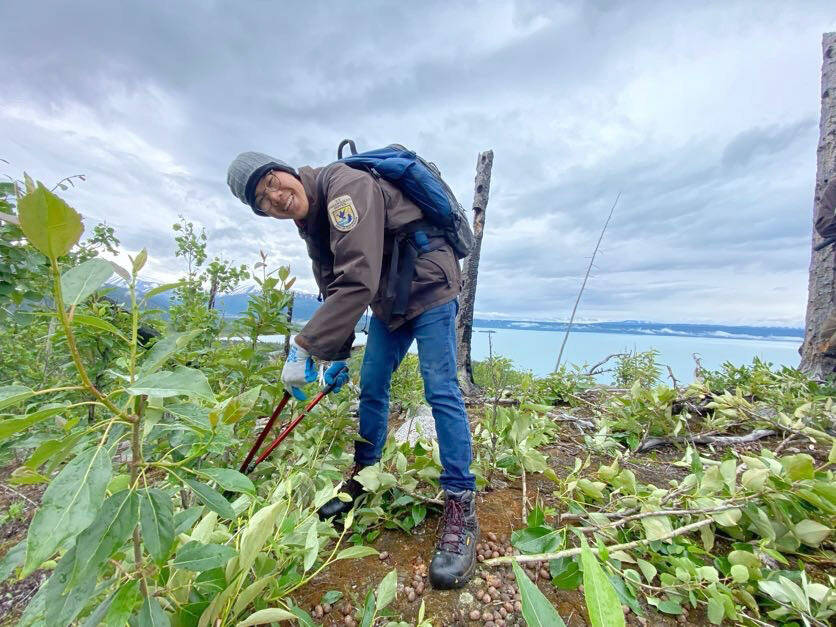They’re everywhere: a munched branch on the trail, muddy boot prints in the house, the rippling of water after a floatplane takes off. All of them traces.
Some traces are less harmful than others. Moose munch on birch twigs for lunch, and hikers follow their crumb trail. Gray pellets stuffed with small bones and fur are a sure sign that owls are near.
These types of traces can help us learn about our environment and the furry residents that travel through it. Some human-caused traces have different effects, with the potential to be detrimental to outdoor spaces.
So, Leave No Trace, founded in 1994, provides a framework of principles and action items to help combat this issue. The Leave No Trace coursework is best taught outside, where practice can be put into play.
For a handful of 15- to 18-year-old teens, the Kenai National Wildlife Refuge became their outdoor classroom and office for the summer. The Youth Conservation Corps had six members this season: Olivia Somers, Ethan Bowser, Lynnea Hack, Aiden Sullivan, Ryan Chen and Jackson Marion.
They worked together to complete trail maintenance work, including installing new trailhead signs, clearing brush along the trail and weed-whacking campgrounds. The eight-week program is loosely modeled after the Civilian Conservation Corps of the Great Depression era.
These projects all contribute to the Youth Conservation Corps mission of resource protection and promoting environmental stewardship. Monday through Friday, the group worked tirelessly to help make the refuge a better place for wildlife and people. In some ways, it all melts down to alleviating the density of human traces on the local flora and fauna.
Managing human impact can look different on any given day. A daunting task for a single soul, teamwork really does make the dream work around here.
On one day, it looked like screwdrivers and patience. Corps members learned the fundamentals of hand tools during their term. (No motorized tools are allowed in the Youth Conservation Corps.)
During the group’s first week, the motley crew replaced damaged foot brushes at trailheads. These “scrushes” are tools that hikers can use to fight against the spread of invasive species that may have clung to their boots.
On a larger scale, the Youth Conservation Corps, trail crew and the Student Conservation Association joined forces to replace rotting boardwalk in the Swan Lake Canoe System in July. Without a sturdy, durable surface to walk on, users would be tripping through wet bogs with heavy canoes, all while crushing the spongy moss.
A Youth Conservation Corps member commented that this was the most difficult “lifting” we’d done all summer. The crew heartily agreed. However, the positive impact we were creating for years to come was impossible to ignore. The crew retired home with sore muscles and content hearts.
I believe that environmental education should be part fieldwork experiences, and also part science-based facts. As crew leader, I’m always contemplating the most effective way to convey a deeper message to my team.
How do I like to teach the seven principles of Leave No Trace to a bunch of high-schoolers? Through rap.
After some initial eye rolls and subtle disses, the Youth Conservation Corps crew agreed and found their rhythm. Each member was assigned a principle to memorize and demonstrate. The product is not only entertaining, but memorable.
“Tell me, I forget. Show me, I remember. Involve me, I understand.” This is a Chinese proverb that has shaped my experiential education since first grade.
This quirky Leave No Trace rap has stuck with me for five years; not so much the pamphlet literature I mulled over during a Leave No Trace trainer course. I aimed to provide the same experience for those who came after me.
The crew laughed as they brainstormed unique ways to show their principles. Jackson decided that a dog not picking up its own poop was a gross protest to the third principle: Dispose of Waste Properly.
All in all, when asked about lessons taken away from the Youth Conservation Corps, Olivia Somers (youth leader), said it best: “Do the best with what you have at the time.”
Apparently, some humility, rhymes and a mediocre beat is all it takes to create an impact that will last a lifetime. That is certainly what the YCC and I did this summer.
Shea Imgarten serves as the YCC Crew Leader for the 2023 season at Kenai NWR. You can find more information on the refuge at http://kenai.fws.gov or http://www.facebook.com/kenainationalwildliferefuge. Look for Refuge Notebook Articles on the first and third Fridays of each month or Find past Refuge Notebook articles (1999–present) at https://www.fws.gov/kenai-refuge-notebook.

